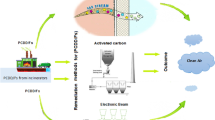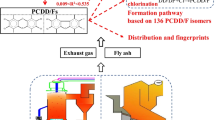Abstract
Unintentionally produced persistent organic pollutants (UPOPs) include polychlorinated dibenzo-p-dioxins and dibenzofurans (PCDD/Fs), dioxin-like polychlorinated biphenyls (dl-PCBs), pentachlorobenzene (PeCBz), and hexachlorobenzene (HxCBz). With the booming of municipal waste incinerators (MWIs) in China, the emission of UPOPs has generated great concern. As an alternative technology of dioxin control, catalytic decomposition has not been used in China, mainly due to the absence of national demonstration projects. Also, the simultaneous removal of various UPOPs has not been well investigated.
In this study, a pilot-scale selective catalytic oxidative (SCO) system using a self-developed honeycomb catalyst was built and tested in a typical municipal waste incinerator (MWI) of China. The original concentration of PCDD/Fs in flue gas after the treatment of activated carbon injection (ACI) still exceeded the national emission standard (0.1 ng I-TEQ/Nm3), while the concentrations of PeCBz and HxCBz were one order of magnitude higher than that of PCDD/Fs. For the testing temperature varying from 300 to 200 °C, the removal efficiency of PCDD/Fs range from 39 to 95 %, followed by dl-PCBs with the range of 56–89 %. PeCBz and HxCBz were also removed, though their removal efficiencies were lower than those of PCDD/Fs and dl-PCBs. Both temperature and degree of chlorination influence the removal efficiencies.





Similar content being viewed by others
References
Amirova Z, Weber R (2015) Massive PCDD/F contamination at the Khimprom organochlorine plant in Ufa-a review and recommendations for future management. Environ Sci Pollut R 22:14416–14430
Chang MB, Chi KH, Chang SH, Yeh JW (2007) Destruction of PCDD/Fs by SCR from flue gases of municipal waste incinerator and metal smelting plant. Chemosphere 66:1114–1122
Debecker DP, Delaigle R, Hung PC et al (2011) Evaluation of PCDD/F oxidation catalysts: confronting studies on model molecules with tests on PCDD/F-containing gas stream. Chemosphere 82:1337–1342
Finocchio E, Busca G, Notaro M (2006) A review of catalytic processes for the destruction of PCDD and PCDF from waste gases. Appl Catal B: Environ 62:12–20
Fangmark I, Stromberg B, Berge N, Rappe C (1994) Influence of postcombustion temperature profiles on the formation of PCDDs, PCDFs, PCBzs, and PCBs in a pilot incinerator. Environ Sci Technol 28:624–629
Fangmark I, Vanbavel B, Marklund S et al (1993) Influence of combustion parameters on the formation of polychlorinated dibenzo-p-dioxin, dibenzofurans, benzenes, and biphenyls and polyaromatic hydrocarbons in a pilot incinerator. Environ Sci Technol 27:1602–1610
Hung PC, Chen QH, Chang MB (2013) Pyrolysis of MWI fly ash—effect on dioxin-like congeners. Chemosphere 92:857–863
Hung PC, Chang SH, Lin SH et al (2014) Pilot tests on the catalytic filtration of dioxins. Environ Sci Technol 48:3995–4001
Lee JE, Jurng J (2008) Catalytic conversions of polychlorinated benzenes and dioxins with low-chlorine using V2O5/TiO2. Catal Lett 120:294–298
Lavric ED, Konnov AA, Ruyck JD (2005) Surrogate compounds for dioxins in incineration. A review Waste Manage (Oxford) 25:755–765
Liljelind P, Unsworth J, Maaskant O, Marklund S (2001) Removal of dioxins and related aromatic hydrocarbons from flue gas streams by adsorption and catalytic destruction. Chemosphere 42:615–623
Liu G, Zheng M (2013) Progress in the studies associated with formation and emission of unintentionally produced persistent organic pollutants. Scientia Sinica Chimica 43:265–278
Koskenniemi JJ, Virtanen HE, Kiviranta H et al (2015) Association between levels of persistent organic pollutants in adipose tissue and cryptorchidism in early childhood: a case–control study. Environ Health 14:78–87
NBS (2014) China statistical yearbook. China Statistics Press, Beijing
Nie Z, Zheng M, Liu W et al (2011) Estimation and characterization of PCDD/Fs, dl-PCBs, PCNs, HxCBz and PeCBz emissions from magnesium metallurgy facilities in China. Chemosphere 85:1707–1712
Syc M, Fiserova E, Karban J et al (2015) The effect of transient operations on the levels and congener profiles of PCBz, PCPh and PCDD/F in raw flue gases of MSWI plant. Chemosphere 118:261–267
Tian Y, Nie Z, Tian S et al (2015) Passive air sampling for determining the levels of ambient PCDD/Fs and their seasonal and spatial variations and inhalation risk in Shanghai, China. Environ Sci PollutR 22:13243–13250
USEPA (2006) An inventory of sources and environmental release of dioxin-like compounds in the years (Final, Nov 2006)., http://cfpub.epa.gov/ncea/risk/recordisplay.cfm?deid = 159286&CFID = 53107448& CFTOKEN = 59682957
Wikstrom M, Tysklind E, Marklund S (1999) Influence of variation in combustion conditions on the primary formation of chlorinated organic micropollutants during municipal solid waste combustion. Environ Sci Technol 33:4263–4269
Wallerstein C (1999) Japan tackles dioxin levels. Br Med J 318:830–830
Weber R, Sakurai T, Hagenmaier H (1999) Low temperature decomposition of PCDD/PCDF, chlorobenzenes and PAHs by TiO2-based V2O5-WO3 catalysts. Appl Catal B: Environ 20:249–256
Yang Y, Yu G, Deng S et al (2012) Catalytic oxidation of hexachlorobenzene in simulated gas on V2O5-WO3/TiO2 catalyst. Chem Eng J 192:284–291
Zhang S, Huang J, Yang Y et al (2015) Rapid mechanochemical synthesis of VOx/TiO2 as highly active catalyst for HCB removal. Chemosphere 141:197–204
Zhou H, Meng A, Long Y et al (2015) A review of dioxin-related substances during municipal solid waste incineration. Waste Manage (Oxford) 36:106–118
Acknowledgements
This study was supported by the National High Technology Research and Development Program of China (2013AA06A305), the Program for Changjiang Scholars and Innovative Research Team in University (IRT1261), and the Collaborative Innovation Center for Regional Environmental Quality.
Author information
Authors and Affiliations
Corresponding author
Additional information
Responsible editor: Philippe Garrigues
Electronic supplementary material
Below is the link to the electronic supplementary material.
ESM 1
(PDF 109 kb)
Rights and permissions
About this article
Cite this article
Li, Y., Yu, G., Huang, J. et al. Catalytic decomposition of dioxins and other unintentional POPs in flue gas from a municipal waste incinerator (MWI) in China: a pilot testing. Environ Sci Pollut Res 25, 31799–31804 (2018). https://doi.org/10.1007/s11356-016-6554-z
Received:
Accepted:
Published:
Issue Date:
DOI: https://doi.org/10.1007/s11356-016-6554-z




